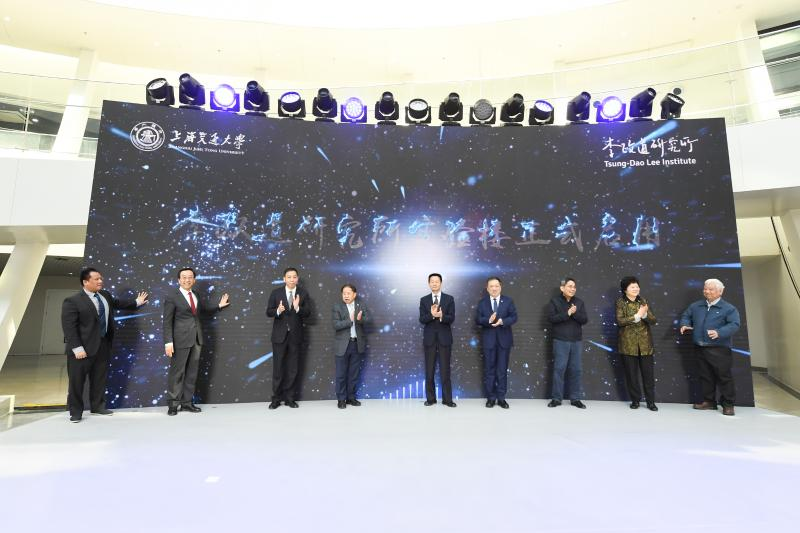On August 4, 2024, at 2:33 a.m. local time in San Francisco, Professor Tsung-Dao Lee, a globally esteemed scientist, Nobel Laureate, and Chinese-American physicist, passed away peacefully at home at the age of 97. Professor Lee was a distinguished member of the scientific community, holding esteemed positions, including Foreign Academician of the Chinese Academy of Sciences (CAS), a member of The World Academy of Sciences (TWAS), the National Academy of Sciences (NAS), the American Academy of Arts & Sciences, and Italy's Accademia Nazionale delle Scienze (National Academy of Sciences). He also held lifelong tenure as the director of the China Center of Advanced Science and Technology (CCAST) and was an honorary professor of Shanghai Jiao Tong University (SJTU), as well as the honorary director of Tsung-Dao Lee Institute of SJTU.
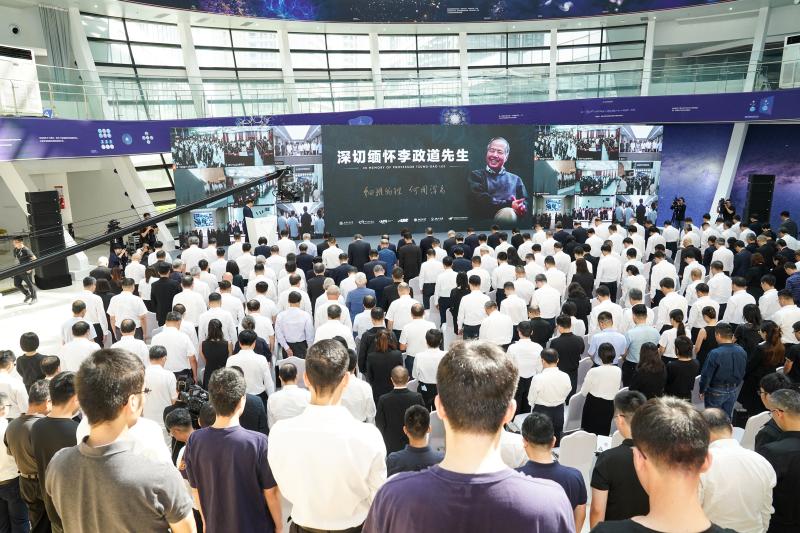
Party and state leaders, including Xi Jinping, Cai Qi, Ding Xuexiang, Li Ganjie, Hu Jintao, Zhu Rongji, Wen Jiabao, Jia Qinglin, Li Lanqing, Zeng Qinghong, Wu Guanzheng, Li Changchun, He Guoqiang, Shen Yiqin, Wang Zhaoguo, Liu Yandong, Liu He, Lu Yongxiang, Chen Zhili, and Song Jian, have expressed their deep condolences on the passing of Professor Tsung-Dao Lee and extended their heartfelt sympathies to his family.
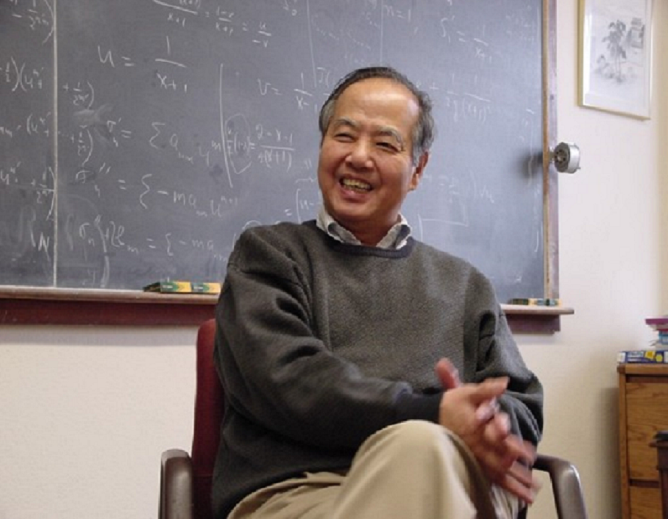
Tsung-Dao Lee in his office in Columbia University
(Provided by Tsung Dao (T. D.) Lee Library)
On August 25, 2024, the "Memorial Service for Professor Tsung-Dao Lee" was held at the Tsung-Dao Lee Institute at Shanghai Jiao Tong University. The service was jointly organized by Shanghai Jiao Tong University, the Chinese Physical Society, the American Physical Society, the International Union of Pure and Applied Physics, Peking University, Zhejiang University, and the Institute of High Energy Physics, Chinese Academy of Sciences. The event was live-streamed in both Chinese and English, attracting over 2.42 million viewers globally. In accordance with the wishes of Professor Lee and his family, the service was chaired by Professor Zhang Jie, Director of the Tsung-Dao Lee Institute, President of the Chinese Physical Society, and a ‘close friend beyond generations’ of Professor Lee.
Representatives from the American Physical Society, the International Union of Pure and Applied Physics, domestic universities and research institutions, friends of Professor Lee, CUSPEA Program, and Hui-Chun Chin & Tsung-Dao Lee Endowment Program also spoke at the service. Professor Lee's eldest son, Professor James Z. Lee, and his eldest grandson, Professor Andrew S. Lee, delivered eulogies on behalf of the family.
Throughout his illustrious life, Professor Tsung-Dao Lee was a globally renowned scientist and an outstanding educator, writing a magnificent chapter in scientific exploration and talent cultivation. Specifically, his vision for the Tsung-Dao Lee Institute to become a world-class research institution remains a work in progress. Along with counterparts, Tsung-Dao Lee Institute will continue to honor Professor Lee's legacy, striving to fulfill his commitment and vision to advance fundamental research in China.
President Ding Kuiling of Shanghai Jiao Tong University provided a biographical overview of Professor Tsung-Dao Lee's life. Representatives from various social sectors worldwide, along with Professor Lee's family members and Shanghai Jiao Tong University faculty and students, gathered to express their profound respect, deep condolences, and sincere remembrance.
Young-Kee Kim, President of the American Physical Society, Michel Spiro, President of the International Union of Pure and Applied Physics, and Frank Wilczek, Nobel Laureate in Physics and Chief Scientist of the Tsung-Dao Lee Institute, expressed their deep sorrow for the passing of Professor Lee.
Academician Wang Yifang of the Chinese Academy of Sciences stated, "In Professor Lee's nearly century-long legendary life, there is an abundance of precious spiritual wealth worth remembering and passing down. Reflecting on his life, we are reminded of his profound and vast scientific achievements, as well as his deep affection to homeland and dedication to the development of science and education in China. Professor Lee's passing is a significant loss to China's scientific community."
He Zuoxiu, an alumnus of Shanghai Jiao Tong University and a fellow physicist of Professor Lee, recalled their shared experiences in physics. In 1945, He Zuoxiu entered Shanghai Jiao Tong University and later participated in the development of China's atomic bomb. He shared, "Because we were of similar age, Professor Lee and I had many common experiences and much to discuss with each other. During a critical period when our country needed to advance its scientific capabilities, he arranged for me and my colleagues to form a five-person delegation to the United States to study theoretical physics research. This three-month visit greatly broadened our horizons and allowed us to establish connections with many fellow scientists. Professor Lee made significant contributions to the development of science in China. He was a great scientist and always held China to his heart."
Professor Lee deeply understood the importance of young talent for advancing science. At the Service, Guo Yong, Deputy Party Secretary of Tsinghua University, and Ren Yuzhong, Vice President of Peking University, highlighted Professor Lee's support for their universities and China's higher education system. They mentioned that in 1979, Professor Lee initiated and co-organized the China-U.S. Physics Examination and Application (CUSPEA) program, which selected and recommended a group of outstanding students for advanced studies in the United States, creating a new model for the cultivation of high-level talent urgently needed in China. Many students passed the CUSPEA exams and went to the United States for further studies, later making significant contributions in their respective fields. In the mid-1980s, at Professor Lee's active advocacy and suggestion, China formally established the postdoctoral system, effectively promoting the training of senior researchers urgently needed by the country. This system allows countless young talents to further their academic career and later achieve remarkable accomplishments in scientific research.
As the President of the Chinese Physical Society, Academician Zhang Jie summarized Professor Lee's scientific achievements, stating, "Professor Lee made pioneering and landmark contributions in many fields, including quantum field theory, particle physics, nuclear physics, statistical mechanics, fluid dynamics, and astrophysics. Among these achievements, six are of Nobel Prize level, and most are also foundational contributions in many fields." He added that from Professor Lee’s visit to China in 1972 to his last visit in 2010, he made 49 visits over 38 years, making numerous foundation laying contributions to the development of China’s science and talent cultivation. Jie also emphasized that Professor Lee's expectation for the Tsung-Dao Lee Institute to make significant contributions to fundamental scientific questions and become a world-class research institution still requires collective efforts.
Professor James Lee, Director of the Tsung Dao (T. D.) Lee Library of Shanghai Jiao Tong University, Chair Professor at the Hong Kong University of Science and Technology, and Professor Lee's eldest son, expressed his gratitude on behalf of the family for the condolences and support extended by all sectors of society following Professor Lee's passing. In his heartfelt remarks, James Lee shared that Professor Lee not only inspired their intellect but was also a source of strength and vitality for the family. "My father taught me to explore knowledge, pursue truth, focus on work, be humble, responsible, maintain national pride, be upright, appreciate art, value family and friendships, and strive for meaningful achievements rather than pursuing wealth, material gains, or fame. In his final days, my father would say, 'I will always be a part of you, and you will always be a part of me.' Although only family members were present at that moment, I believe my father’s words were not just for us, but for his many teachers, colleagues, and friends over the years, and for the eternal sciences and his beloved homeland."
As one of the pioneering Chinese physicists to receive a Nobel Prize, Professor Tsung-Dao Lee published 321 academic papers throughout his over sixty-year career. His groundbreaking contributions span multiple fields, including quantum field theory, fundamental particle theory, nuclear physics, statistical mechanics, fluid dynamics, and astrophysics. With a profound attachment to his roots, Professor Lee devoted his exceptional scientific insight to advancing China's scientific and educational development, fostering international collaboration, and nurturing talent, leaving a legacy of historical significance. As a visionary who championed the integration of science and art, he collaborated with several of China's top artists, infusing scientific ideas into artistic creations and leaving behind timeless works rich in meaning and beauty.
The Ministry of Science and Technology, the Ministry of Human Resources and Social Security, the Ministry of Education, the Chinese Academy of Sciences, the Chinese Academy of Engineering, the National Natural Science Foundation of China, and other national ministries and related departments; the Shanghai Municipal Party Committee and Municipal Government, the Suzhou Municipal Party Committee and Municipal Government, the Pudong New Area Party Committee and Government, and other local governments and related commissions and offices; the China Association for Science and Technology, the Chinese Physical Society, the Chinese Nuclear Society, the American Physical Society, the British Physical Society, the Physical Society of Japan, the International Union of Pure and Applied Physics, the Association of Asia Pacific Physical Societies, the Korean Physical Society, the Nepal Physical Society, the Shanghai Association for Science and Technology, the Suzhou Association for Science and Technology, the CUSPEA Scholars Association, and other academic organizations; Peking University, Tsinghua University, Fudan University, Shanghai Jiao Tong University, Zhejiang University, University of Science and Technology of China, Xi'an Jiaotong University, Hong Kong University of Science and Technology, Lanzhou University, Shanxi University, East China Normal University, ShanghaiTech University, Soochow University, Huzhou University, Southern University of Science and Technology, Hainan Normal University, Northwest University; Columbia University, Oxford University, University of Chicago, Princeton University, University of Tokyo, and other domestic and international universities and research institutions; as well as friendly organizations such as Lowrie Institute, Kashing High School, Zhejiang Province, Suzhou Arts High School in Jiangsu Province, International Scientific Exchange Foundation of China, and the K.C Wang Education Foundation, have expressed their deep condolences on the passing of Professor Tsung-Dao Lee and extended their heartfelt sympathies to his family.
A Deep Bond with Shanghai Jiao Tong University Spanning Over Four Decades
Why was Professor Tsung-Dao Lee's memorial service held in Shanghai? Why were the Tsung-Dao Lee Institute and Tsung Dao (T. D.) Lee Library established at Shanghai Jiao Tong University (SJTU? There are two main reasons: first, his longstanding friendly relationship with SJTU, and second, his deep and enduring friendship with Academician Zhang Jie, the Director of the Tsung-Dao Lee Institute and former President of SJTU.
The connection between Tsung-Dao Lee and SJTU dates back to 1978. That year, to help SJTU faculty and students stay abreast of the latest developments in international physics, Professor Lee donated three "Physics Lectures" and two physics exercises to the university, providing valuable support for its educational development.
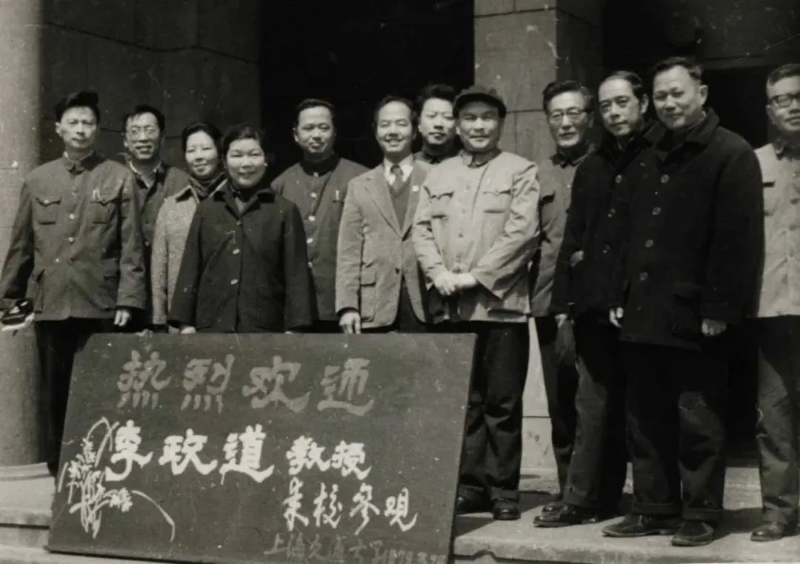
In 1979, Tsung-Dao Lee made his first visit to SJTU, during which he donated a computer to the Department of Engineering Mechanics and discussed the exchange of researchers and students. In May of the same year, he first proposed establishing the China-U.S. Physics Examination and Application (CUSPEA) program. This visit played a significant role in shaping his design of the CUSPEA program.
In 1987, in recognition of his contributions to promoting international cooperation in education and science, fostering talent, and supporting technological advancements at the university, SJTU appointed Tsung-Dao Lee as an Honorary Professor. During the appointment ceremony, he encouraged SJTU students to "maintain self-esteem and confidence."
The China-U.S. High-Energy Physics Collaboration, one of the endeavors Tsung-Dao Lee valued most, was also one of the earliest and longest-running collaborative projects between the two countries following China's reform and opening-up. In 1979, thanks to his tireless efforts and networking, China and the United States signed the "China-U.S. High-Energy Physics Cooperation Agreement" during Deng Xiaoping's first visit to the U.S., establishing the first bridge for Sino-American scientific cooperation. From 2003 to 2006, Academician Zhang Jie served as the head of the Chinese delegation in the China-U.S. High-Energy Physics Cooperation talks. Under the personal guidance of Tsung-Dao Lee, Zhang Jie creatively resolved numerous challenges in Sino-American scientific cooperation, earning Lee's deep trust and becoming his "close friend across generations."
In 2006, Zhang Jie assumed the President of SJTU. This greatly enhanced Tsung-Dao Lee's understanding of the university. In 2009, at the invitation of President Zhang, Tsung-Dao Lee visited SJTU, delivered a scientific lecture titled " From the Language of Heaven to the Rationale of Matter," and engaged in in-depth discussions with faculty and students.
In 2010, Tsung-Dao Lee made a special visit to Shanghai Jiao Tong University, where he had several late-night discussions with then-President Zhang Jie at his former residence on Wanping Road. Following these conversations, he decided to entrust Shanghai Jiao Tong University with his Nobel Prize medal, as well as his lifetime collection of manuscripts, letters, books, artworks, and the residence on Wanping Road. In 2011, Zhang Jie made a special trip to Columbia University, where after numerous discussions, Tsung-Dao Lee agreed to name a library showcasing these precious donations after him.
In 2014, with the approval of national leaders, central ministries, and the Shanghai Municipal Government, the Tsung Dao Lee Library was established at SJTU. It became the most comprehensive and systematic repository of Tsung-Dao Lee's related materials, serving as a centre for the promotion of his scientific achievements, academic contributions, moral integrity, and affection for his homeland. It plays an active role in promoting research on the history of contemporary science and education in China and spreading the spirit of scientists.
In 2013, Tsung-Dao Lee established the "Tsung-Dao Lee Science and Art Lecture Fund" at Shanghai Jiao Tong University. This fund supports scientific seminars and national art competitions with a focus on the integration of science and art, aiming to foster innovative talents who can merge these two fields creatively.
In memory of his wife, Hui-Chun Chin, and to enable undergraduates to engage in scientific research and interact with active scientists early on, Tsung-Dao Lee established the " Hui-Chun Chin and Tsung-Dao Lee Chinese Undergraduate Research Endowment (CURE)" in 1998 with his savings.
In 2013, SJTU joined the CURE, with the goal of "cultivating scientific elites and leaders with a global vision and innovative thinking." To date, twelve sessions have been held, with 604 faculty-student teams receiving project grants and 401 CURE Scholars being trained. In 2015, Tsung-Dao Lee personally wrote to the participating universities, transferring the CURE management to SJTU. The first CURE Management Committee website was also independently designed and developed by SJTU students.
In 2016, at Tsung-Dao Lee's suggestion, the Party and the state supported the establishment of the Tsung-Dao Lee Institute at Shanghai Jiao Tong University, focusing on overcoming fundamental scientific challenges and cultivating world-class talent. At the end of 2021, Tsung-Dao Lee entrusted Academician Zhang Jie with leading the institute's continued development. Under Director Zhang's guidance, TDLI has concentrated on fundamental scientific issues, uniting the world’s leading scientists to conduct cutting-edge research in physics and astronomy. The institute aspires to become a world-leading research institution, making significant contributions to the progress of human civilization.
Prof. Lee’s family also has a deep connection with SJTU. As early as 1911, Tsung-Dao Lee's father-in-law, Qin Mengjiu, graduated from the Shanghai Advanced Industrial School under the Ministry of Posts and Communications, the predecessor of SJTU. He later held various positions, including as a tax officer in the Ministry of Finance and an accountant in the Audit Office. In 1926, Qin Mengjiu donated part of the funds from selling his residence in Beijing to help build the Industrial Hall (now the Engineering Hall in the Xuhui Campus), supporting SJTU's development. In the 1950s, Tsung-Dao Lee's fifth brother, Lee Xuedao, and his younger sister, Lee Yayun, both graduated from the Shipbuilding Department of SJTU. Lee Xuedao later taught in the Shipbuilding Department in the 1960s, and Lee Yayun taught in the Department of Solid Mechanics in the 1970s. In the early 2000s, Tsung-Dao Lee's eldest son, Professor Lee Zhongqing, was appointed as a Visiting Chair Professor at SJTU, serving as the Director of the Northeast Asia History and Society Research Center in the School of Humanities and as the Director of the Tsung Dao Lee Library since 2014.
Tsung Dao (T. D.) Lee Library : "Inspiring the Youth to Reach New Heights in Science"
In the northwest corner of SJTU’s Minhang Campus, the Tsung Dao Lee Library stands quietly. Its pale yellow exterior is elegant and understated, harmonizing beautifully with the reddish-brown Nobel Hill. This library houses the Nobel Prize in Physics medal that Tsung-Dao Lee donated to SJTU, along with tens of thousands of other invaluable materials he gifted, which will be permanently preserved here. These items continue to exhibit and spread Professor Lee's scientific spirit and unwavering commitment to his homeland.
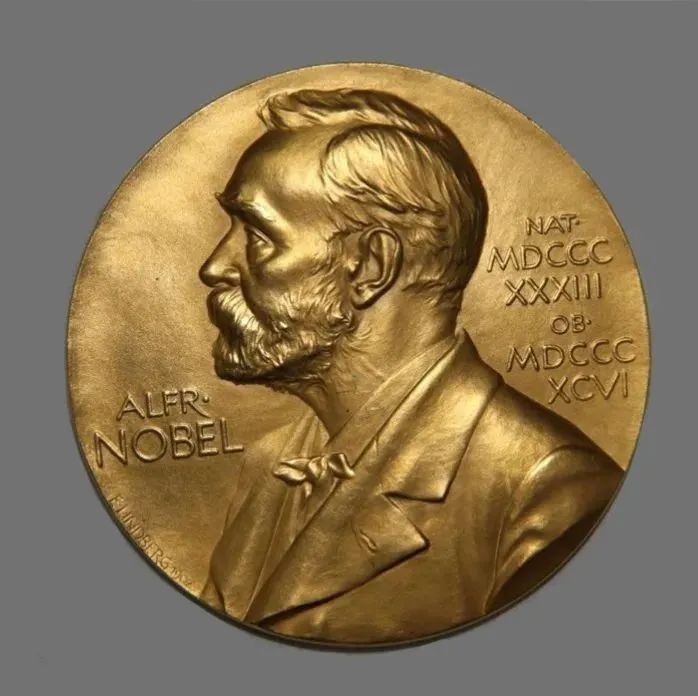
The 1957 Nobel Prize in Physics awarded to Professor Tsung-Dao Lee
(From the collection of Tsung Dao (T. D.) Lee Library )
Professor Tsung-Dao Lee maintained a long-standing friendship with SJTU. In 2006, when his "close friend across generations," Academician Zhang Jie, was appointed President of SJTU, it significantly deepened Lee's understanding of the university. Between 2010 and 2011, Tsung-Dao Lee and Academician Zhang Jie had several in-depth "candlelight conversations," during which Lee profoundly resonated with SJTU's culture and philosophy of talent cultivation. Consequently, he decided to entrust SJTU with his lifelong collection of manuscripts, medals, artworks, and his former residence, to inspire future generations.
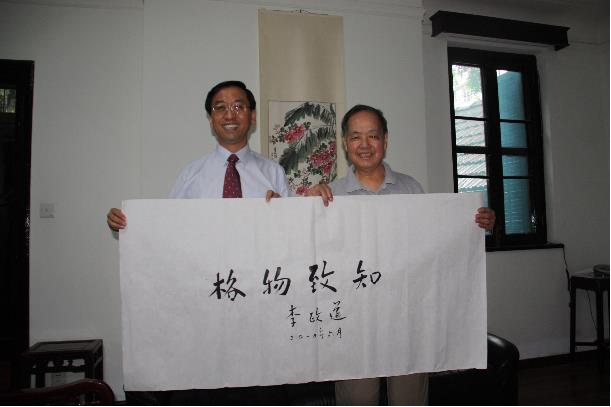
In June 2010, Tsung-Dao Lee met with Academician Zhang Jie
Beginning in 2011, Professor Lee gradually donated more than 80,000 precious items, including the original Nobel Prize medal, to SJTU. To better preserve and utilize this collection, with the approval of national leaders and the Ministry of Education, it was decided to build the Tsung Dao Lee Library on the Minhang Campus of SJTU. After three years, a distinctive themed facility was erected, becoming a new cultural landmark on the Minhang Campus.
From the initial design to construction and functional positioning to exhibit layout, the Tsung-Dao Lee Library received meticulous attention and strong support from Professor Tsung-Dao Lee and his close associates from the beginning. Professor Lee was deeply involved in many aspects of the project. In 2012, after reviewing the design plans, he wrote to then-President Zhang Jie, suggesting, "The sloped area in the design reminds me of the steps in front of Columbia University's Low Library, where students gather on sunny days to sit, lie down, work, reflect, or discuss. These steps are ideal for fostering both self-directed and collaborative learning." This input led to creating a large platform and podium on Nobel Hill. Professor Lee was equally meticulous with the exhibition layout, reviewing every detail, providing handwritten notes, and translating the exhibition themes. This led to the well-curated permanent exhibit "From the Language of Heaven to the Rationale of Matter."
On December 28, 2014, the Tsung Dao Lee Library officially opened, with Professor Lee serving as its Honorary Director and his eldest son, Professor James Lee, serving as THE Director. At the opening ceremony, Professor Lee spoke of his original intention in establishing the library: "Throughout history, it has always been the young who produce talents for the nation. Scientific talents come from the youth, and talent cultivation is not limited to classroom education. I donated my lifetime collection of scientific literature and research manuscripts to Shanghai Jiao Tong University in the hope of benefiting future generations." He earnestly expressed his wish that young students "find inspiration here, and that the young friends who come to the Tsung Dao Lee Library will be inspired to successfully reach the pinnacle of scientific achievement."
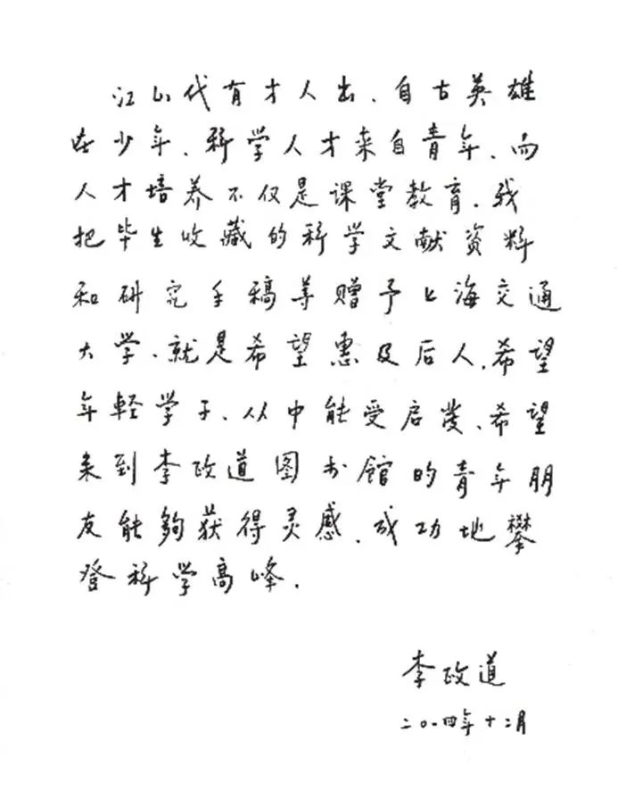
Since its opening, the Tsung sDao Lee Library has faithfully followed Professor Lee's vision to benefit future generations. It maintains a unique "five-in-one" role as a library, archive, museum, science museum, and art museum. The library, built on a foundation of resources and dedicated to service, supports not only SJTU faculty and students but also extends its influence to nearby primary and secondary schools and the "NeoBay" Science and Technology Innovation Zone, impacting the city's scientific and educational landscape.
This "five-in-one" approach transcends traditional single-function models, creating a dynamic educational space that integrates scientific research, science and art, and the spirit of scientific inquiry. Over the past decade, the Tsung Dao Lee Library has become the most comprehensive repository of Tsung-Dao Lee's materials, showcasing his scientific achievements and contributions while serving as a key platform for promoting his scientific legacy.
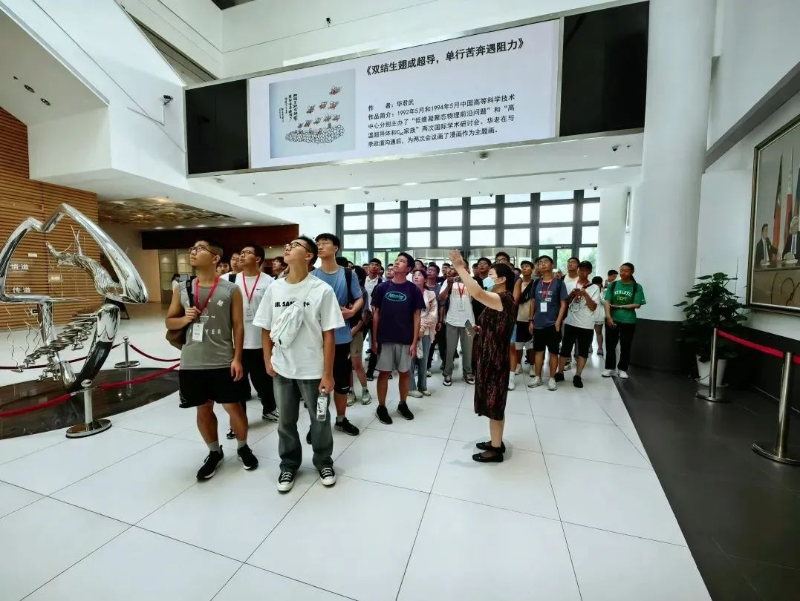
We remember Tsung-Dao Lee for his connection to the universe and his heartfelt devotion to his nation. His nearly century-long life in physics has written an immortal chapter in the history of science. His brilliant achievements in physics and selfless dedication to the future of Chinese science will forever be recorded in the annals of science; his broad-minded and persistent scientific spirit will continue to inspire generations of Chinese scientists and students to strive tirelessly, forging new glories for Chinese science and technology.
Tsung-Dao Lee Institute: Establishing a World-Class Frontier Research Institution,Shaping a Global Beacon of Technological Innovation
In December 2014, Professor Tsung-Dao Lee proposed to central government leaders the creation of a world-class research institute in China, inspired by the impactful Niels Bohr Institute. His vision was for an institution that would attract top global scientists, cultivate a culture of free academic inquiry, and develop a new generation of leading scientists in China. This would drive major advancements in physics and related fields. The proposal garnered significant support from the Party and national leaders. With support from the Ministry of Science and Technology, the Ministry of Education, the National Natural Science Foundation of China, and the Shanghai Municipal Government, Tsung-Dao Lee Institute (TDLI) was officially established at Shanghai Jiao Tong University (SJTU) on November 28, 2016.
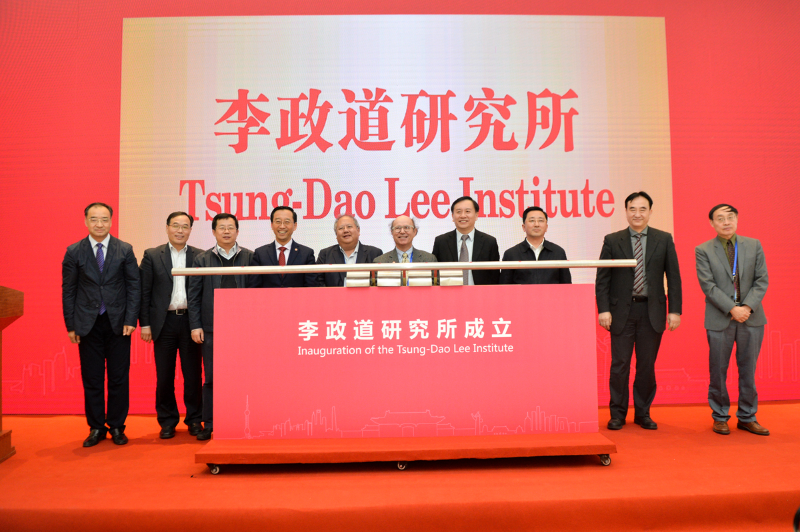
SJTU responded enthusiastically to the national call, aligning closely with the country’s goals and fully supporting the development of the Tsung-Dao Lee Institute as part of the effort to build a comprehensive national science center. After five years of construction, the institute’s building was inaugurated on December 3, 2021. Professor Lee's eldest son, James Lee, and his eldest grandson, Andrew Lee, delivered congratulatory messages on behalf of Professor Lee. Although unable to attend this historic event, Professor Lee expressed his deep joy and excitement in a letter. He was profoundly touched by the sustained attention and support from Party and national leaders, various ministries, the Shanghai Municipal Government, and SJTU. Professor Lee expressed confidence that with everyone’s joint efforts, TDLI would attract top-tier talent and achieve significant scientific breakthroughs.
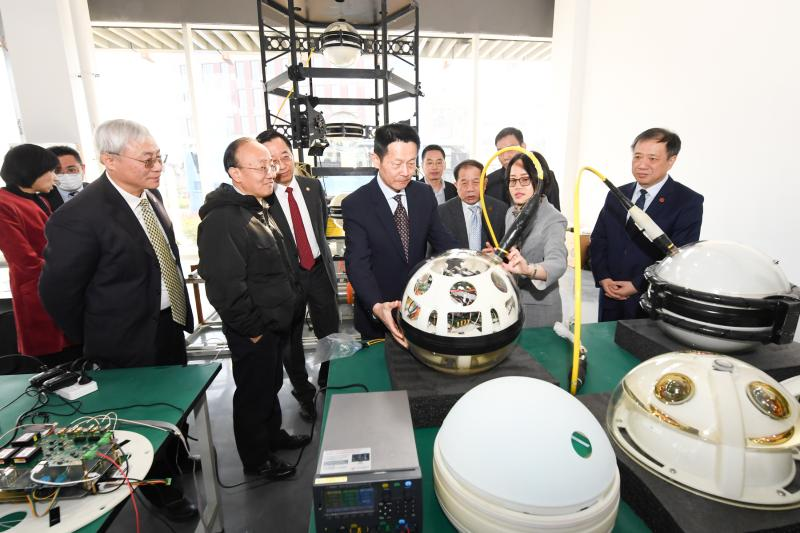
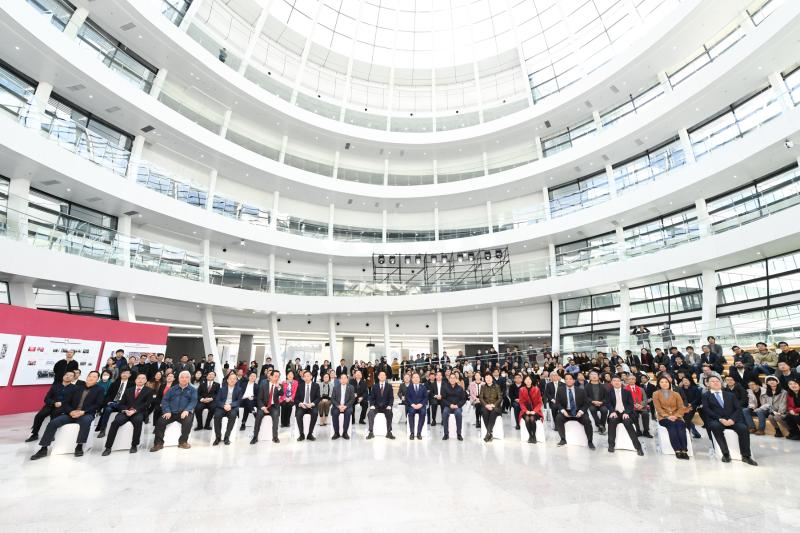
“Tsung-Dao Lee Institute carries the expectations of the Party and national leaders, as well as Professor Tsung-Dao Lee's wishes. I understand the honor and responsibility of this mission,” said Academician Zhang Jie, TDLI's director and a close friend across generations of Professor Lee. During its first five years, TDLI completed the construction of its building in the core of Shanghai's Zhangjiang Science City. It established three primary research areas: Astronomy and Astrophysics, Particle and Nuclear Physics, and Condensed Matter Physics, each with its own research team.
Under Director Zhang’s leadership, the institute finalized the "Tsung-Dao Lee Institute 2035 Vision" bilingual version in early 2023. This plan envisions tackling fundamental scientific questions, utilizing the strengths of large-scale research paradigms, and leveraging the advanced detection capabilities of specialized scientific facilities and research platforms. The goal is to create a "Shanghai School of Thought" in fundamental research, drive Shanghai's development as a global hub of technological innovation, nurture top-tier scientists, and elevate the institute to a world-class center for fundamental science research with significant academic impact by 2035.
In 2023, TDLI held the Physics and Astronomy Discipline Meeting and the International Advisory Committee Meeting, inviting nearly fifty distinguished scholars and academicians from physics and astronomy. These experts comprehensively evaluated TDLI 2035 Vision and the institute's progress. They unanimously endorsed the Vision and praised the TDLI’s progress over the past two years, expressing strong confidence and high expectations for TDLI’s future development.
To explore fundamental scientific questions, TDLI has established three specialized research platforms in Shanghai Zhangjiang and three remote observation sites with advanced detection capabilities. The research platforms include experimental setups for laboratory astrophysics and topological materials, as well as a large-scale public computing platform. The observation sites feature:
- The deep underground PandaX Dark Matter and Neutrino Detector in Jinping, Sichuan
- The TRIDENT Neutrino Telescope located 3,500 meters deep in Hainan
- The JUST Spectral Telescope situated 4,300 meters above sea level in Lenghu, Qinghai
By leveraging these state-of-the-art facilities, the institute conducts organized, collaborative scientific research. In recent years, TDLI has achieved significant progress and breakthroughs in fundamental scientific questions across Particle and Nuclear Physics, Astronomy and Astrophysics, and Condensed Matter Physics.
For example,
- The PandaX team’s PandaX-4T experiment has once again set the most sensitive limit in the search for dark matter, determining for the first time globally the upper limit on the charge radius of dark matter and imposing the strongest constraints on its potential electromagnetic properties;
- The TRopIcal DEep-sea Neutrino Telescope (TRIDENT) collaboration has identified an excellent site for its telescope;
- Yosuke Mizuno, as one of the coordinators of the EHT Theory and Simulation working group, contributed to the EHT collaboration’s capture of the polarized image of the M87 supermassive black hole, providing stringent constraints on the existence of axions using the polarization data of M87*.
- Academician Zhang Jie and colleagues have discovered a new method for efficiently generating extremely brightness GeV gamma rays through the interaction of electron beams with solid targets, advancing our understanding of the origins of ultra-high-energy cosmic rays in the universe and the mechanisms for the efficient production of extremely brightness GeV gamma rays;
- Academician Jia Jinfeng and Professor Zheng Hao’s team have, for the first time, realized a segmented Fermi surface in superconductors, solving a 58-year-old unresolved problem, and were recognized as one of the "Top Ten Scientific Advances in China" for 2022;
- Liu Xiaoxue and colleagues have provided the first experimental evidence of the fractional anomalous quantum Hall effect, offering new insights for research in topological quantum computing and related fields.
TDLI is focused on advancing China’s scientific progress and innovation. It explores innovative management approaches for research institutions and plays a key role in Shanghai’s development as a leading science and innovation hub. TDLI remains committed to advancing Professor Lee's legacy, fulfilling his vision of enhancing fundamental research for the benefit of humanity.
